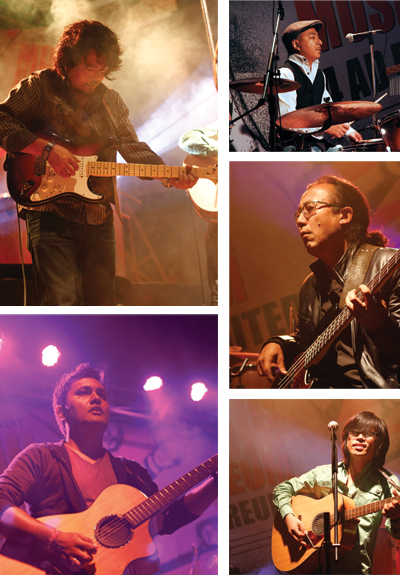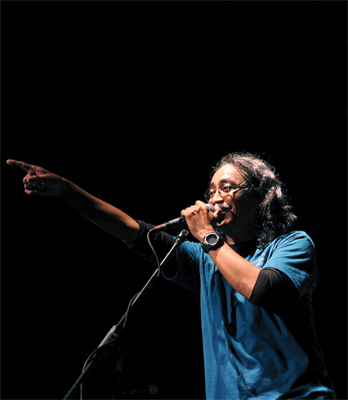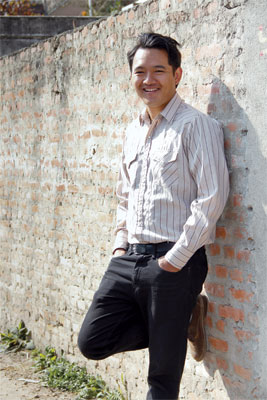Only with a folk music revival are Nepali music lovers realizing that folk music had in fact never really gone away.
The cultural scene in Nepal today is an excellent indicator of the times and development. Even though we’re more connected to the world than ever before, the fact that the artists producing exciting new work – music, paintings, photography, street culture, clothing – are looking increasingly inward for influences is proof of the scene coming of age.
Folk music is a celebration of this realization – that although we might look to the West for influences and inspiration, when we combine this knowledge with our own cultural history, we come up with ideas and approaches that are truly Nepali and more importantly truly unique. Only just a few years ago, folk music performances in the Valley used to be sporadic. The only places you would hear it were on public transport or as novelty performances catering to foreigners. The problem seemed to be that most people identified with folk music as being backward. That was then – things have changed.
Folk music has always been more than this – it’s the voice of Nepal’s rural countryside, of a demography that still makes up more than 80% of the country’s population. Its melodic choruses and beats carry the nostalgia of distinct Nepali events – fathers leaving for work, sons leaving to become lahures, the crippling sandess of losing a loved one to sickness, waiting for a letter from the hulaki and the more joyous and universal emotions of love and longing.
It’s debatable whether today’s folk music can even be called folk – what do urban youth know of these strange emotions one might say. But just as our culture is only truly ours when we are affected by it and add to it, today’s folk music still has the same soul. The times are different but core human emotions remain unchanged. As the music of the musicians, singers and bands featured here will ably testify, folk is still very much the rtue voice of the Nepali people.
 Identity & Continuity
Identity & Continuity
Text By Krita Raut
1974 AD’s Manoj Kumar KC talks about the band’s reasons for including folk songs in every album and its universal appeal.
No matter where we are playing, the whole ambience of the concert changes when we play folk music. The crowd totally gets in the mood,” shares Manoj Kumar KC, guitar player for one of Nepal’s most popular bands, 1974 AD. The band, which is going to celebrate its 20th anniversary next year, has played numerous concerts in both national and international venues. What KC shared is something the band has experienced in all of their concerts. “Even if there is not a single Nepali in the crowd, folk music doesn’t fail in creating that upbeat and fun mood with it’s equal appeal to foreigners,” he adds. The band usually plays a medley of popular folk songs during their live performances. Songs like Gurans Phulyo Banai ma and Lekali are regular numbers in their playlist.
Although the lyrics part isn’t highly influenced, KC shares that since the rhythm section is stronger in Nepali folk, they choose to include that in their music. “Nepali tunes are in major scales. They are in 6/8 times signature so the main essence of Nepali music is that more than musical variety it’s stronger in rhythm and is also lyric-oriented. Even Nepali music theory has more rhythm concept,” he says. He strongly believes that instruments like the madal, khne, sarangi and murchunga among others make our music sound different, thus making it “exotic”.
So, does the band make a point to include folk songs in their album? “Yes, while we are shaping up an album we make a conscious effort that two or three songs in it are more of Nepali folk and contemporary blended with western,” he replies. They have included both Purbeli (eastern) and Paschimeli (western) folk tunes in their albums. And he is well aware that they aren’t alone as bands like Nepathya, Night and musicians like Lochan Rijal are also playing the same genre. “Lochan and Nepathya even do research and I really admire what Night is doing. Abhaya and the Steam Injuns and other bands are also using folk tunes, so it is definitely not lost.” There is lot of be explored as well, “Most of the times when we think of Nepali folk music, we only think of those from the mountains and hills but there are so many others like Newari folk and the Terai region is also rich in music. There is a huge variety to tap in to.”
According to KC their vocalist Phiroz Syangden, who is more into Nepali contemporary music, was the one who took care of the folk songs in their album. Though the band’s music is more influenced by the hard rock that evolved in the West during the 70s and Nepali contemporary music of the same era, the band’s insistence on making folk a part of their identity is more than just about preserving it. “It is about giving continuity to our own tunes, folk music is in our blood -- it is our identity.”
 Melodies From the countryside
Melodies From the countryside
Text By kshitiz singh, Photo courtesy nepalaya
Nepathya’s music borrows from the country’s wide soundscape - its new songs are in fact the melancholy of the old country.
Adding a drop of water in the ocean, that’s what we’ve merely done,” says Amrit Gurung, the frontman and guardian of Nepal’s most popular folk pop band Nepathya, by way of explaining the band’s contribution to Nepali music. Established in 1991, the band has caressed fame and huge appreciation from their loyal fanbase since their starting days. Gurung however claims to not having a proper direction set while forming the band.
Nepathya represents the folklore and melodies of settlements hidden in the numerous folds of the hills and in the deep valleys guarded by the world’s tallest snowy peaks. The journey of converting these raw melodies from the wilderness to fine studio sounds began from their second album,“Himal Chuchure”, where the title track had audiences jiving to the song’s beats. Recalling the process of archiving the song, Gurung explains, “This tune from the Gandaki region was amongst the favorites of the gaaineys who’d come to our houses during the harvest season. I knew the song’s melody but it wasn’t until my early school days that the song caught my attention. A group of hippies performed the song at my school using guitars and the song got stuck in my mind. Years later, when I proposed recording the song, everyone agreed and so began our journey of archiving folk tunes.” The archiving process has since then gotten stronger as they got more popular with every album and many more hits with roots strongly linked to Nepali folk music and more importantly to Nepali folks.
One of their biggest hits, Sa Karnali - a tune from Nepal’s rural far western Dolpo region – triggered a trend of presenting the landscape and the views of Nepal’s beautiful yet unseen vistas which the band did for their songs’ music videos. Gurung believes that the trend not only made some great videos but also helped in uplifting the local tourism in those provinces. With a few documentary films under their belt, Nepathya presented their musical efforts on screen too. Amongst them, the critically acclaime, “Bheda ko oon jasto…in search of a song”, shows the quest for the song ‘Bheda ko oon jasto’ in the cold trails leading up to the holy Gosainkunda lake. When asked how easily locals gave away their folk tunes in their journeys to rural villages, Gurung answerd, “There’s a lot of luck involved in this process. You might hear people singing a song that catches your attention in the middle of the forest or sometimes behind closed doors. It would not be rational to force them to sing the same tune over and over again until they feed our recorder. When you’re dealing with women, things could get even complicated. We have waited for days in the same place to get comfortable enough to ask for the song. Many times we have returned empty-handed.”
The band who believe in using their music to become active socially has spoken out against the harsh situation Nepalis are facing, through their famed tour, “Sundar Shanta Nepal” and “Shanti ko Lagi Shikshya”. According to the frontman Amrit Gurung, in the future too, the band will continue to spread messages of social awareness through their music and lyrics – all with a tinge of the Nepali hills, mountains and rivers that inspire the melodies..
 Introducing Neo Nepali Folk
Introducing Neo Nepali Folk
Text By utsav shakya, Photo By ecs media
A Nepali musician trying to make it in the huge US market, Diwas’ folk experiments are introducing folk music to many youth.
This much is true about real musicians everywhere – they are people who are true to their emotions. No matter what they tell others and or even themselves, when words escape their mouths or notes escape their instruments, fed into the amplifiers, through the wires into the speakers for all to hear, it sets them open like pages in the wind. There is no hiding.
I am watching Nepal’s premier rock band Albatross and their former guitar player Diwas Gurung in their element at Thamel’s live music restaurant House of Music. On a winter’s afternoon, HoM has a deserted feel. In daylight, the place looks different; “smells like a hangover” says a friend stopping by to say hello. It sounds like something else though - pure, unadulterated Nepali rock music.
Although Diwas took a hiatus from the local scene, he’s not stayed idle. In Ithaca, USA where he went to college and played with his former band Ayurveda, he’s been busy writing new songs for Photoreal, the new band he formed with some members from Ayurveda. He’s also working on plenty of new Nepali songs – most of which have a distinctly pop-folk flavor to them. The songs, a few of which he performed at a charity event in Lazimpat’s Asian Village restaurant, easily remind of the nostalgic melancholy of 80’s Nepali pop. The kicker comes in when Diwas introduces electronic grooves and builds deliciously thick layers of curious sounds. For anyone who was fond of Nepali pop back then but soon got tired of the formulaic ways of the compositions, Diwas’ music will delight. A few days before this show, at another one in Jhamsikhel’s Moksh, although most came for Albatross’ alternative rock, Diwas’ covers of popular Nepali folk numbers almost stole the show.
Humble and softspoken but never one to shy away from playing a prank, Diwas says he never really planned his foray into folk music. “It started with performing at a Nepali folk night at a club called The Nines where we’d play The Beatles and Tom Petty covers and throw in some Nepali numbers. I also started listening to old tapes that my father sent me with renditions of old folk songs,” says Diwas. Among these songs was Machhi Kadaile, an enthusiastic folk number and Mai Runchhu, a tearful lullaby originally written in Dolpa. This was also when Diwas started recording Rato Mato, his folk covers album that was received very well by music lovers in Kathmandu.
Although Diwas says that his music is inspired from various sources like movies and even other art, the stories behind how he ended up covering some of the songs on Rato Mato point to another strong influence in his life and in his music too -- his family. The latter has always been very supportive of Diwas’ music despite him originally leaving for the US to pursue a degree in Economics which he successfully completed. For instance, the version of Machhi Kadaile on the tape was sung by Diwas’ musician father for Diwas’ mother on the request of her friends. At the Asian Village show, the first to start dancing were members of Diwas’ family.
But its not all play as a musician in the US, says Diwas. “When we’re performing in the New York City area, we usually just drive back the 4 hours to our homes,” he says. His passion for what he does seems to justify it all. He makes this quite apparent when he talks of how he likes to listen to music
“The vinyl record is making a comeback. The vinyl is more of an active listening experience as opposed to tracks on your iPod where the songs become background noise. With vinyl, its an event. I can have some wine or beer while I sit down to listen to some music or maybe even call friends over for dinner and plan an event around it.”











